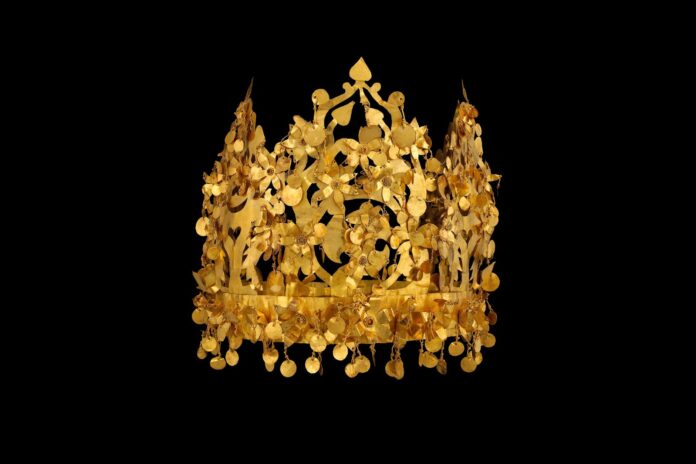
After the Taliban take over Afghanistan, the country’s archaeological remains await a bleak future, even if an extremist Islamic group chooses not to plunder or deliberately destroy them.
Some news reports suggest the Taliban are already looking for one of the country’s most famous caches; The so-called “Bactrian Treasure” is a collection of more than 20,000 artifacts, many of which are made of gold, that was found in 2000-year-old graves at a site called Tilla Tepe in 1978.
Afghanistan’s most famous golden treasure was kept at the National Museum of Afghanistan and exhibited at the presidential palace, but its current whereabouts are reportedly unknown. Other archaeological finds that could be threatened by the Taliban include Mes Ainak, a Buddhist city that flourished about 1,600 years ago.
The city was located on the famous Silk Road and was used for both trade and worship. Numerous ancient Buddhist monasteries and other ancient Buddhist artifacts are buried here. When the Taliban ruled Afghanistan between 1996 and 2001, they destroyed many of these Buddhist artifacts, including two massive sixth-century statues known as the “Buddha of Bamiyan”, which were carved into the rock.
According to news reports, the extremist group used rockets, tank shells, and dynamite to demolish the tall statues.

The future of Mes Ainak looks particularly bleak as sources said that all equipment used for excavation and conservation at the site has disappeared, and the Taliban visit this place for unknown purposes.
Khair Muhammad Khairzada, the archaeologist who led the excavation at Mes Ainak, said that all the equipment they used to excavate and preserve at Mes Ainak “disappeared.”
China has mining rights in the surrounding areas. Even before the Taliban seized power, archaeologists feared that parts of the site could be destroyed if turned into a mine. After the Taliban took over Kabul, they said they would seek economic support from China, but it is unclear if China intends to build a mine in the area.
Julio Bendeso-Sarmiento, who was the head of the French archaeological delegation in Afghanistan, said he became aware of the Taliban’s visit to Mes Ainak, but it is unclear why. There was a plan to hold an exhibition of Afghanistan’s most famous golden treasure, artifacts from Mes Ainak, and other places in Afghanistan in France in 2022. But the Taliban captured Kabul before the artifacts could be transported.
This 1st-century gold, turquoise, garnet, and lapis pendant is one of a pair found at Tillya Tepe depicting the “Dragon Master”, a figure from ancient myths. It illustrates the merging of many cultures along the Silk Road including Bactrian, Persian, Indian, Chinese, and Roman.

So far, there have been no reports of deliberate destruction of artifacts by the Taliban. The Taliban leadership has made statements that they will protect archaeological sites. However, it is not known whether the Taliban will actually deliver on their promises.
A huge 2,000-year-old gold treasure is known to have disappeared in Afghanistan, and the Taliban are trying to find it.
Known as the “Bactrian Treasure” or “Bactrian Treasure”, it is approximately 21,145 gold coins in the form of jewelry, coins, weapons, crowns, and other items adorned with precious stones and jewels. The invaluable collection is known as one of the largest gold collections in the world. It represents the history and culture of the Ancient Silk Road.
The treasure was discovered in 1978 and 1979 in six nomadic graves for five women and one man, about two hours by car west of Mazar-i-Sharif.
One of the graves belonged to a young woman in her thirties, whom Viktor Sarianidi, the Soviet leader of the excavation, called “a nomadic princess.”Inside, there were Roman coins minted in the first century AD in present-day Lyon, France, daggers with Siberian bears, an Indian medallion with an early Buddha image, intricate gold belts, and a 5-inch-high sheet gold crown that was even folded for transport.

After the treasure was discovered, it was taken to the Kabul National Museum for safekeeping. As the Soviet occupation continued and fighting around Kabul became more regular, moved it to the Presidential Palace Kabul, known as the Arg, and then, a few years later, to a three-story dungeon.
When the Soviet Union left Afghanistan in 1989, rumors began to circulate about the whereabouts of the treasure. Lots of people thought the Soviets had taken the treasure. The others believed it had been melted down and sold for weapons or sold on the black market safe and sound. Those who knew were silent, making an unofficial oath to protect the treasures.
The few people who knew about the location of the Bactrian treasures were silent and for good reason. The Taliban became famous for the destruction of ancient artifacts and monuments that did not fit their fundamental interpretation of Islam.

After the Taliban won a victory in the post-Soviet civil war in 1996, many artifacts disappeared from the Kabul National Museum. Omar Khan Masoudi, who served as the director of an Afghan museum, estimated that during the chaos that erupted, roughly 70% of the museum’s items were stolen by robbers and likely ended up on the black market. Although some of them have been restored, they are most likely gone forever.
























